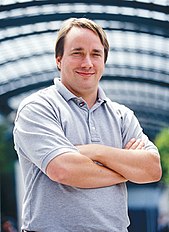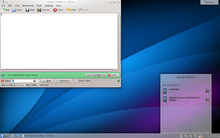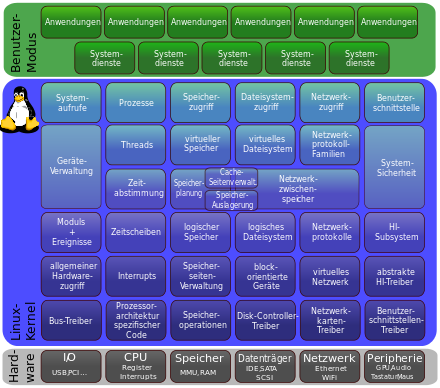Linux
![]()
This article covers operating systems that use the Linux kernel. For the kernel, see Linux (kernel). For other meanings, see Linux (disambiguation).
As Linux (German [ˈliːnʊks]![]() ) or GNU/Linux (see GNU/Linux name dispute) one usually refers to free, Unix-like multi-user operating systems based on the Linux kernel and essentially on GNU software. The wide, also commercial spreading was made possible starting from 1992 by the licensing of the Linux kernel under the free license GPL. One of the initiators of Linux was the Finnish programmer Linus Torvalds. He still plays a coordinating role in the further development of the Linux kernel and is also known as the Benevolent Dictator for Life.
) or GNU/Linux (see GNU/Linux name dispute) one usually refers to free, Unix-like multi-user operating systems based on the Linux kernel and essentially on GNU software. The wide, also commercial spreading was made possible starting from 1992 by the licensing of the Linux kernel under the free license GPL. One of the initiators of Linux was the Finnish programmer Linus Torvalds. He still plays a coordinating role in the further development of the Linux kernel and is also known as the Benevolent Dictator for Life.
The modular operating system is further developed by software developers around the world who collaborate on the various projects. Companies, non-profit organizations and many volunteers are involved in the development. When used on computers, so-called Linux distributions are usually used. A distribution combines the Linux kernel with various software to form an operating system that is suitable for end use. In the process, many distributors and savvy users adapt the kernel to their own purposes.
Linux is used in many different ways and extensively, for example on workstations, servers, mobile phones, routers, notebooks, embedded systems, multimedia terminals and supercomputers. Linux is used with varying degrees of frequency: Linux is a permanent fixture in the server market and in the mobile sector, while it still plays a minor but growing role on desktops and laptops. In March 2021, it was installed on 2.19% of systems in Germany.
Linux is used by a wide range of users, including home users, governments, organizations, and businesses.
History
→ Main article: History of Linux
Developments in the run-up
In 1983 Richard Stallman started the GNU project. The goal was to create a freely available Unix-like, POSIX-compatible operating system. Although a considerable amount of software had already been written in the early 90s, the actual operating system kernel (GNU Hurd) was still in an early phase and developed only slowly. The equally free Berkeley Software Distribution, which had developed in the 1980s, was involved in a legal dispute with an uncertain outcome and for this reason was also not an alternative as a free operating system. Thus, in the early 1990s, there was no complete free system available that would have been of interest to developers.
Historical development
In 1991, Linus Torvalds began developing a terminal emulation in Helsinki, Finland, in order to better understand his own computer, among other things. Over time, he noticed that the system was becoming more and more like an operating system; as a result, he announced it in the Usenet topic group for the Minix operating system, comp.os.minix. In September of that year, the system was to be made available on a server to interested parties. The FTP server administrator at the time, Ari Lemmke, did not like either of the names Freax or Buggix suggested by Torvalds, so he published it in a directory named Linux instead. Torvalds did not agree with this name at first, but quickly gave up his resistance because, according to him, he had to admit that Linux was simply a better name.
Linux was still released under a proprietary license by Torvalds at that time, which prohibited commercial use. However, he soon realised that this was hindering the progress of development. He wanted to give all developers much more freedom and therefore put Linux under the GNU GPL in January 1992. It was now possible to integrate Linux into GNU and distribute it as the first free operating system. This step made the system more interesting for an even larger number of developers because it simplified modification and distribution.
The term GNU/Linux
The name Linux was initially used by Torvalds only for the kernel he wrote. This was initially used on Minix. Torvalds and the other Linux authors licensed Linux under the GNU GPL in 1992 so that the kernel could be integrated into GNU. This GNU variant quickly became the most widely used, as there was no other viable free kernel at the time. When Torvalds and his followers later also referred to the entire operating system as Linux, the founder of the GNU Project, Richard Stallman, soon tried to enforce the name GNU/Linux in order to give the role of GNU what he considered appropriate validity. This demand met with different reactions. While the GNU Project and the Debian Project accepted the name, most developers and other Linux distributors refused or clearly opposed it. This was justified on the one hand by convenience, because the name Linux was seen as simpler, and on the other hand by pointing out that by now a considerable amount of the software shipped with Linux did not originate from the GNU project.
See also: GNU/Linux name dispute
Development
The development of the Linux kernel is still organized by Torvalds. He is employed by the non-profit Linux Foundation for this purpose. Other important developers are often paid by various companies. For example, Andrew Morton works on the Linux kernel on behalf of Google and is responsible for collecting all changes and forwarding them to Torvalds in the so-called merge window.
In addition to kernel development, other projects have gathered around the operating system, making it interesting for a larger number of users. For example, graphical user interfaces such as KDE or Gnome enable a high level of user comfort when used as a desktop system. Various Linux distributions designed for the desktop simplified the installation and configuration of Linux to such an extent that even beginners can master them without any problems.
A worldwide community of developers and users is creating a great deal of additional software and documentation around Linux, which has greatly expanded the possibilities for use. In addition, manufacturers of proprietary software are increasingly recognizing a market among Linux users and are offering more and more programs for Linux over time. At the same time, the development of mainly free software is taking place both in self-organised projects consisting of voluntary and paid developers, and in foundations partly supported by companies. What all models have in common is that they are strongly networked via the Internet, where a large part of the organization and coordination takes place.
Dispute about Linux
Early on, controversy arose around Linux. In 1992, Andrew S. Tanenbaum attacked Linux for what he saw as an outdated design and too liberal a development model. Later, Tanenbaum came into the fray again when Ken Brown was writing his book Samizdat and looking for evidence that Linux was just a copy of Tanenbaum's Minix. Tanenbaum came to Linux's defense this time. Linux had too bad a design to be copied.
Other disputes were with declared competitors. Early on, internal Microsoft documents (Halloween documents) became public, revealing that Microsoft believed Linux was the biggest threat to Windows. Later, Microsoft began a campaign to make Windows look good in a face-off with Linux, both technically and economically. While the community was quite calm about this campaign, especially companies in the Linux environment started counter-campaigns. In autumn 2006, however, Microsoft and Novell announced that they would work together on interoperability and patent protection in order to improve cooperation between the individual products.
Another competitor, the Unix manufacturer SCO, in turn raised the accusation in 2003 that Linux developers employed by IBM had copied source code from SCO's Unix into Linux. The proceedings were discontinued in the summer of 2007, and the SCO Group has since filed for bankruptcy and been barred from trading on the stock exchange. In 2013, a motion was filed to reopen the case. The dispute is documented chronologically in the article SCO v. Linux.
Trademark law also gave Linux a hard time early on. In the mid-1990s, some private individuals registered the name Linux in their own name, which Torvalds was only able to reverse with a lot of help. He transferred the administration of the trademark rights to the Linux Mark Institute, which in turn attracted attention in 2005 when it set the licenses for trademark protection at up to $5,000 per year. This sum mainly upset many minds involved in community projects, whereupon Torvalds felt compelled to take a stand in an open letter and clarify that the money was simply needed so that the non-profit Linux Mark Institute could cover its own costs.

Linus Torvalds, 2002

Graphical user interface KDE
The kernel
→ Main article: Linux (kernel)
Technology
The name Linux was initially used by Linus Torvalds only for the kernel, which provides the software with an interface with which it can access the hardware without knowing it in detail. The Linux kernel is a monolithic kernel written in the C programming language, using some GNU-C extensions. However, important subroutines as well as time-critical modules are programmed in processor-specific assembly language. The kernel allows to load only the drivers necessary for the respective hardware. Furthermore, the kernel also handles the allocation of processor time and resources to the individual programs that are started on it. In the individual technical processes, the design of Linux is strongly oriented towards its role model Unix.
The Linux kernel has been ported to a very large number of hardware architectures in the meantime. The repertoire ranges from rather exotic operating environments like the iPAQ handheld computer, navigation devices from TomTom or even digital cameras to mainframes like IBM's System z and, more recently, mobile phones like the Motorola A780 as well as smartphones with operating systems like Android or Sailfish OS on the Jolla. Despite the modular concept, the basic monolithic architecture was retained. The orientation of the original version towards the widespread x86 PCs led early on to efficiently supporting the most diverse hardware and enabling the provision of drivers even for inexperienced programmers. The resulting basic structures spurred the spread.
Kernel versions
All kernel versions are archived on kernel.org. The version to be found there is the respective reference kernel. The so-called distribution kernels are based on this kernel and are supplemented by the individual Linux distributions with additional functions. A special feature is the version numbering scheme consisting of four numbers separated by dots, e.g. 2.6.14.1. It provides information about the exact version and thus also about the capabilities of the corresponding kernel. Of the four numbers, the last one is changed for bug fixes and cleanups, but not for new features or deep changes. For this reason, it is rarely included when comparing kernel versions, for example. The penultimate, third number is changed when new capabilities or features are added. The same applies to the first two numbers, but for these the changes and new features must be more drastic. As of version 3.0 (August 2011), the second digit is omitted.
Development process
Due to the GPL and a very open development model, the development of Linux is not in the hands of individuals, corporations or countries, but in the hands of a worldwide community of many programmers, who primarily exchange information via the Internet. In many e-mail lists, but also in forums and in Usenet, everyone has the possibility to follow the discussions about the kernel, to participate in them and also to actively contribute to the development. This uncomplicated approach ensures a fast and steady development, which also brings the possibility that everyone can add capabilities to the kernel that they need. This is only limited by the control of Linus Torvalds and a few specially selected programmers who have the final say in the inclusion of improvements and patches. In this way, roughly 4,300 lines of new code are created every day, with about 1,800 lines deleted and 1,500 changed every day as well (data according to Greg Kroah-Hartman as an average for the year 2007). Currently, about 100 maintainers for 300 subsystems are involved in the development.
Examples of kernel change details
New features in kernel 2.6
The stable kernel 2.6 was developed from December 2001 on the basis of the then 2.4 kernel and features a number of innovations. The most noticeable effect of these changes is that graphical and interactive applications run significantly faster.
One of the most important changes was the improvement of the so-called O(1) scheduler, which Ingo Molnár completely redesigned for the 2.6 kernel. It has the ability to allocate processor time to different processes in constant time, independent of the number of processes. Since kernel 2.6.23, however, the so-called Completely Fair Scheduler is used instead.
Another innovation is the introduction of access control lists, which allow a very fine-tuned rights management, which is very important especially in environments with many users. The new kernel also has a significantly improved file monitoring system. In the new version, called Inotify, the watcher sends a message every time a file is operated on, which is important for desktop search engines, for example, which can then update their index with respect to this file.

Structure of the Linux kernel in detail
Questions and Answers
Q: What is Linux?
A: Linux or GNU/Linux is a Unix-like operating system (or family of) for computers. It is a collection of basic instructions that manage the electronic parts of the computer allowing running applications and programs.
Q: What makes Linux popular?
A: One reason why many people like to use Linux is because there is a lot of software available for it, and much of this software is free.
Q: Who developed the Linux kernel?
A: The Linux kernel was developed by Linus Torvalds at first alone.
Q: What are some popular distributions of Linux?
A: Popular distributions include Debian, Fedora, Ubuntu, Red Hat Enterprise Linux, SuSE Linux Enterprise Server, X11 or Wayland, GNOME and KDE Plasma.
Q: Is it possible to create custom distributions for specific purposes?
A: Yes, because anyone can freely copy and modify the source code under its respective licenses such as the GNU General Public License.
Q: Where is Linux used most commonly? A:Linux is most commonly used on servers such as mainframe computers and supercomputers; around 2.3% of desktop computers; Chromebooks in US K–12 education market; embedded systems such as mobile phones (especially smartphones), tablet computers, network routers etc.; facility automation controls; televisions; digital video recorders; video game consoles and smartwatches.
Search within the encyclopedia